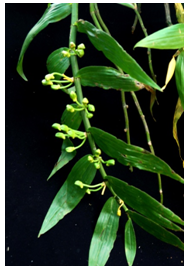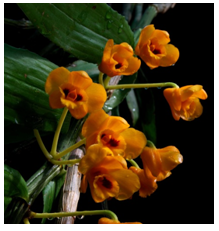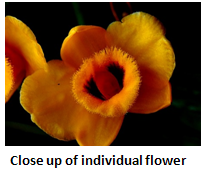Species of the Month – August 2013
Dendrobium chrysanthum Wall.ex.Lindl
Dendrobium chrysanthum is a beautiful species from the diverse and large group of Dendrobiums. It is popularly known as golden yellow flowered Dendrobium. There are several attractive Dendrobiums which are native to India for example; Dendrobium nobile is a very colourful and attractive species which can be seen in collection of most of the growers. Nathaniel Wallich described the species but the name was validly published by John Lindley. Several synonyms are known for this species such as Callista chrysantha, Dendrobium chrysanthum var.anophthalam and Dendrobium paxtonii.
 Distribution: The species is widely distributed from Himalayas, South China to Indo China, Myanmar, Nepal, Thailand, Laos and Vietnam. In India it is seen in Assam, Meghalaya, Nagaland in primary forests where heavy rainfall and high humidity features (as in khasi hills). It occurs at elevations between 800 – 2000 M.
Distribution: The species is widely distributed from Himalayas, South China to Indo China, Myanmar, Nepal, Thailand, Laos and Vietnam. In India it is seen in Assam, Meghalaya, Nagaland in primary forests where heavy rainfall and high humidity features (as in khasi hills). It occurs at elevations between 800 – 2000 M.
Plant: Dendrobium chrysanthum is a beautiful evergreen, epiphytic orchid with long pendulous canes often reaching 5-6 feet. The leaves are alternate, lanceolate, bright and shining green. This is a large sized Dendrobium preferring cool to warm growing conditions. The pendulous canes are with several nodes. Axillary buds from these nodes will open up from May – June onwards. The flowers are short, opposite to leaves and are 1-3 numbered all along the canes which is a sight to see. The flowers are fragrant and fleshy and are orange yellow coloured with two dark blotches and fimbriation at the lip. Flowers are borne on canes with leaves and the leaves will start falling off only after the flowering period is over.

Culture: Dendrobium group is a highly diverse genus in Orchidaceae and many of these genera have varied and different cultural requirements. Because of this, several groups have been formed with common cultural requirements. Dendrobium chrysanthum along with D.fredricksianum, D.nobile and D. wardinaum is put under Group I.
The species requires warmth and prefers a temperature range between 17 – 30° C. They also require high humidity. During the growing season they need bright light, otherwise they grow in partial shade in its natural habitat. As the flowers are produced on the leafy canes which precede a rest period, adequate moisture, light and nutrients have to be provided for the plant which ensures longer canes and better flowering. Hence it is important to provide good long growing season to ensure long canes.
 Plants do very well in hanging baskets and when mounted. In baskets and pots a freely draining media has to be provided. Because of the long pendulous canes, they do well when hung or mounted. When grown in pots provide adequate space for the next two years of growth as they dislike frequent disturbances.
Plants do very well in hanging baskets and when mounted. In baskets and pots a freely draining media has to be provided. Because of the long pendulous canes, they do well when hung or mounted. When grown in pots provide adequate space for the next two years of growth as they dislike frequent disturbances.
Some hybrids have been produced with the species and one of them is ‘Tropgarden Beauty’ which is a cross between DendrobiumNg Eng Cheow and Dendrobium chrysanthum. 
The species is very attractive in bloom and this is also the very reason that the population is declining in the wild because of over collection. The so called ‘orchid collectors’ and ‘Orchid hunters’ are also contributing to its decline in wild. One has to take note, as even if the habitat is ideal and intact, if the population of a particular species is not viable enough, then also the species will be pushed to the brink of endangered. Hence indiscriminate collection is also one of the main reasons for several orchid species declining.
Article contributed by : Dr. K. S. Shashidhar
Thanks a ton dear Doctor saab
I am one Green and Orchid lover who reads this column in regular. Thanks a lot for your very very informative and brief article on one native species. Fortunately I have bought one D. chrysanthum form Nisa orchids, Bangalore. The plant given very very pleasant bloom with a mesmerized gloden flowers in August 2013. Amazing………
But, in other hand I disappointed to see the picture ” Orchid for sale on road side”. I truly in shock to feel that ” is the fate of Orchids-the king of flowers” in India. We must have to aware the people and take actions for its conservation. Must!!!!!! I am always with you to help you to what extreme what it will need.
Once again thanking you.
Yours,
Mr Jyoti Patel,
Odisha, India.
Please correct the article. In the middle some random info is inserted.
The United States physical online casinos lobby group has informed the condition Casino Control Commission and also the Division of Gaming Enforcement (DGE) the world’s biggest online poker clients are “a business built on deceit, chicanery and also the systematic flouting people law.
I am also very sorry to see the orchids being sold as such. That is such a shame. thank you for your article.
regards
Thanks for pointing it out. Seems like some new kind of spam!
Article has been corrected now.
Hi
Thanks for the comments, indeed orchid species in bloom are broght and sold like ‘vegetables’ once, it has come down now possibly due to both awreness and reduction in population. It is the big, bright flowers which is also their own enemy. It is hoped that these articles either directly or indirectly creates awareness about the need for conservation
shashidhar
After a while I got back into the web site and to my wonder, found this article on one of my favorite Dendrobium species. This is in bud now here in Sydney, in my bush house. Well done Dr. Shashidhar, to highlight the plight of his majestic orchid in the wild. One can not say enough on conservation of species, especially Orchids
Thank you Mr. Ramakrishna, it is true indeed to make people aware of this family as it is unlike other flowering plants
shashidhar
Hi,
I find your article very clear and instructive.
I have the opportunity to buy a D. chrysanthum, and it seems to be reasonably appropriate to grow here in Uruguay.
The question I have for you is how long is the flowering period.
Thanks a lot in advance!
Marcelo
Hi, I just got back from a holiday in Meghalaya, and was shocked to see hundreds of orchids sold in the open bazaar, dread to think of the unsold plants